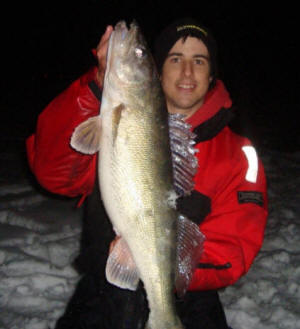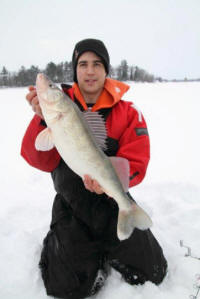 Go
Big or Stay Home – The keys to icing big Walleye Go
Big or Stay Home – The keys to icing big Walleye
by:
Yannick Loranger
Hanging from the side of the 31¬ inches of Ottawa River
gold’s mouth was a 5” golden shiner. It was the second
time that winter that I had topped my personal best for
walleye and one of those eureka moments on the ice. It
was the third oversized walleye I had caught in as many
months and all three on oversized minnows. One is fluke,
two can be luck, but three is a pattern.
Oversize is the right size
We’ve always been told that the best way to catch big
fish, is to use big bait. This strategy has been put to
use thoroughly by muskie and largemouth fishermen who
have been upsizing to 13” swimbaits and 10” worms for
years, but it seems to have been overlooked by most
walleye fishermen who would prefer to offer small subtle
offerings to supposedly finicky walleye. Let the truth
be heard! Big walleye love big baits, and winter time is
the best time to offer large baits to concentrated
populations of oversized gluttonous marble eyes.
For a moment, put yourself in a fish’s scales. Except
for a short period in the year when reproduction is your
key function, your main goal, is to grow. Now put
yourself in a large walleye’s position. You’re
overweight and surrounded by bite sized morsels of low
energy swimming snacks. To thrust your tail to try to
catch one of these minnows would result in a negative
caloric intake. You’re looking for a meal that will
supply you with a big intake of calories in exchange for
a small expansion of energy. You’re instinctually
programmed to find something big and easy.
Location
It’s no secret that walleye will begin migrating towards
spawning grounds months before the actual spawn begins.
Take the
Bay of Quinte as a prime example of that. The
walleye arrive roughly in November and early December
for an April spawn. The same biological principles apply
to all walleye waters, making catching large fish under
the ice a fathomable feat for all walleye fishermen.
River mouths (or even the actual river), adjacent flats,
deep holes off shoals, and bay mouths are all prime
spots to find trophy winter walleye. Once you’ve located
a potential holding area, don’t be afraid to explore all
depths related to this spot. In my experience, walleye
will always be on a “spot” but at different depths on
different days, and obviously at different times of day.
Don’t be afraid to go deeper than your comfort zone, and
more importantly shallower. Flats with as little as four
feet of water can and will hold walleye especially at
dusk and into the night time. Look for areas that hold
perch and other panfish to attract large walleye at
dusk. As mentioned above, large walleye don’t get and
stay large by eating small minnows. As with any kind of
fishing, the key is to fish, where the fish are. You can
use the perfect lure at the perfect time, but if you’re
fishing the wrong area, you’re just washing lures.
Presentations
It’s almost unbelievable to me to still see
fishermen that either don’t jig, or conversely, will
only jig and not have a deadstick. Both jigging and
deadsticking will get large walleye, in almost equal
proportions, but the key is to be adaptable. On some
days, or even some winters, walleye will hit anything
that moves. Adversely, a much more subtle and natural
approach is often necessary. That is why using both a
jigging rod and a deadstick is crucial. Treat every
outing like your first time on a new lake, using go-to,
high confidence presentations first, and then if need
be, moving on to establish the days’ pattern.
Large jigging spoons have become a staple in my big
walleye arsenal. When heading out on a trophy walleye
hunt, I always have a rod rigged with a #7 Swedish
Pimple in either Orange or Blue and another with a
Northland Buckshot. Buckshot spoons have become
synonymous with walleye in recent years and even smaller
sizes like a 3/8th ounce will catch big walleye when the
bigger spoons aren’t getting the job done. On most days
the key to making spoons appealing to large walleye, is
to tip them with large minnows. Golden shiners or large
emerald shiners both work well. My preference is towards
golden shiners due to their hardiness, but if
unavailable I’m still confident using emerald shiners.
Either way, never forget to attach a stinger hook.
 Deadsticks
Have Their Place Deadsticks
Have Their Place
When it comes to eadsticking, my preferred
presentation is a dropshot rig with a #2 dropshot hook
and the lightest sinker I can get away with. Tipped with
a large lip hooked minnow, this set-up has become my
go-to deadstick presentation. It is very rare for me not
to have a dropshot rig in the water unless I’m fishing
very shallow. The advantage of the dropshot rig is that
it can be jigged very effectively, and is also
productive as a deadstick. Just like you’d use a
dropshot for smallmouth bass, let the sinker on a
dropshot rig rest on the bottom and gently lift and
jiggle the minnow on slack line. Feel for a very
distinctive tick when a fish picks up the offering.
Fishing a drop shot rig takes some getting used to. I
always use it on a jigging rod, placed in a rod holder.
Because of the size of the bait, and position of the
hook in the bait, you always have to let the fish “take
it” longer than with other rigs. Also because of the
horizontal position of the hook, a strong hookset is
necessary. When a fish strikes a drop-shot, gently lift
the rod from the rod holder. When you think the fish has
sufficiently taken the bait, slowly lift until you feel
the weight of the fish and then sharply continue the
lift. I like to keep the drag as tight as possible on
the reel, and then loosen it once the fish is hooked.
Occasionally jigging a deadstick serves well to entice
nearby fish to attack. Similarly, leaving a jigging rod
sit for a few moments can also entice bites. Even when
the fish are obviously more prone to hit a deadstick, it
can be wise to continue jigging. Notice how often the
deadsticks closest to where you are jigging will get
hit. When fish are in a neutral mood, jigging may not
catch many, if any fish, but it can certainly serve to
attract fish and trigger feeding instincts.
Rods & Reels - An Uncompromising Compromise
A multitude of ice fishing combos will work nicely on
large walleye. The truth is that even when targeting
large walleye, most of the fish caught will be less than
trophy size. A heavy rod, built solely to handle large
fish will result in overzealous hooksets and less
playability on smaller fish. Because of the range of
fish they can handle, I own a fleet of 27” combos that I
use on both sauger and walleye. Although this set-up is
smaller than ideal for large walleye, it has been a very
suitable compromise and has yet to let me down. The
upside is that it handles smaller, eater size walleye
very nicely. Any rod with a sensitive tip and rigid
front half will handle trophy walleye. When it comes to
reels, drag smoothness is essential. It may be necessary
to manually pull line off the reel during a fish’s
initial runs until the drag is set perfectly. Also, be
extra delicate when the fish is at or nearing the hole.
Large walleye will tend to come up 90% of the way with
ease and then fight vigorously when they approach the
ice. Play these fish gently, and you will be rewarded.
Using tip-ups decreases your ability to effectively play
a fish, hence my preference for using jigging rods even
with deadstick presentations.
 Bring a Camera Bring a Camera
There is a new community-wide respect for large walleye.
Practicing catch and release on large walleye not only
insures the future of a trophy walleye fishery, but also
encourages regeneration for future age classes of
eater-sized fish. Not only are most large walleye
females in their reproductive primes, but they also make
for less than stellar table fare.
Take advantage of the hot first ice bite to enjoy a few
meals of fresh walleye, but when the slow mid-winter
bite has fish in what seems like a dormant state, drop
big baits in high percentage areas, and make room on the
wall...for a lovely replica mount.
Mistakes are a drag
Don’t preset your drag to fight the fish. Keep your drag
at its tightest setting until after you’ve set the hook.
Before you hook onto a big fish, experiment with your
drag to know how much to back off once the fish is
firmly hooked. I know that with my reels, after the
hookset, backing off the drag half a turn will have it
set just about perfectly to fight a big walleye. Drag
smoothness and ease of operation should be main
considerations when purchasing a new reel or combo.
Don’t forget to loosen your drag all the way if you plan
on storing your combos for an extended period of time.
|